The Starch-based Packaging Market is estimated to be valued at USD 8.2 billion in 2025 and is projected to reach USD 15.2 billion by 2035, registering a compound annual growth rate (CAGR) of 6.4% over the forecast period.
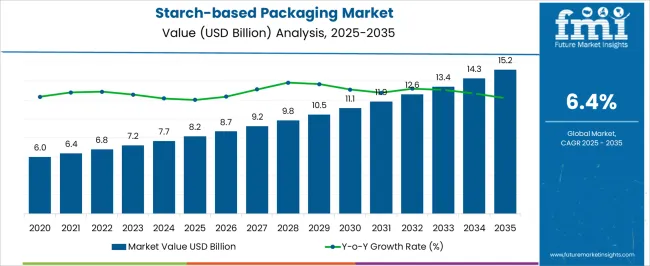
| Metric | Value |
|---|---|
| Starch-based Packaging Market Estimated Value in (2025 E) | USD 8.2 billion |
| Starch-based Packaging Market Forecast Value in (2035 F) | USD 15.2 billion |
| Forecast CAGR (2025 to 2035) | 6.4% |
The starch based packaging market is experiencing rapid momentum as industries transition toward sustainable and biodegradable alternatives to petroleum derived plastics. Growing regulatory restrictions on single use plastics, combined with increasing consumer preference for environmentally friendly products, are accelerating adoption.
Technological improvements in starch blending, barrier coatings, and thermoplastic starch processing are enhancing durability and performance, making these packaging formats more competitive with conventional materials. Rising demand from food service operators and consumer goods companies is further propelling growth, as starch based packaging aligns with global corporate sustainability targets.
The future outlook remains positive with ongoing innovation in compostable films, tableware, and flexible packaging formats that support both environmental goals and commercial scalability.
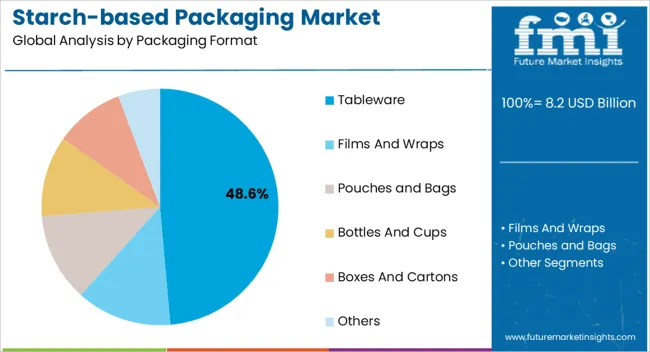
The tableware packaging format segment is expected to account for 48.60% of the total revenue by 2025, making it the leading category. This dominance is supported by rising demand for disposable yet eco friendly tableware solutions across food service outlets, quick service restaurants, and catering businesses.
Increasing consumer awareness of sustainable dining practices and the enforcement of bans on plastic cutlery have further accelerated adoption. Starch based tableware offers biodegradability and functionality, aligning with both consumer preferences and industry sustainability commitments.
These advantages have strengthened the position of tableware as the largest packaging format in the market.
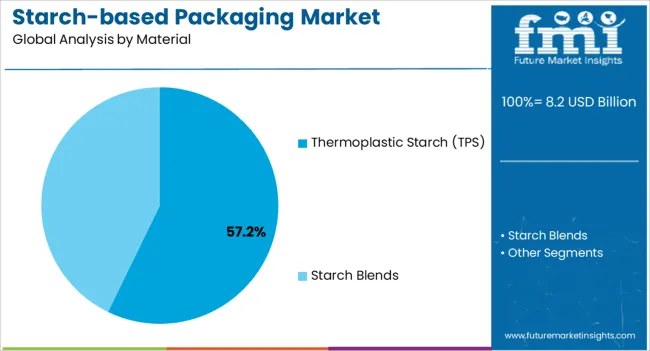
The thermoplastic starch material segment is projected to contribute 57.20% of the overall market revenue by 2025, positioning it as the most significant material category. Its strong growth is attributed to cost effectiveness, ease of processing, and compatibility with existing plastic manufacturing equipment.
Thermoplastic starch can be blended with other biopolymers to improve flexibility and barrier properties, enabling a wide range of packaging applications. The material’s compostable nature also aligns with regulatory and corporate goals for circular economy initiatives.
These attributes have made thermoplastic starch the preferred choice for manufacturers seeking scalable and sustainable packaging solutions.
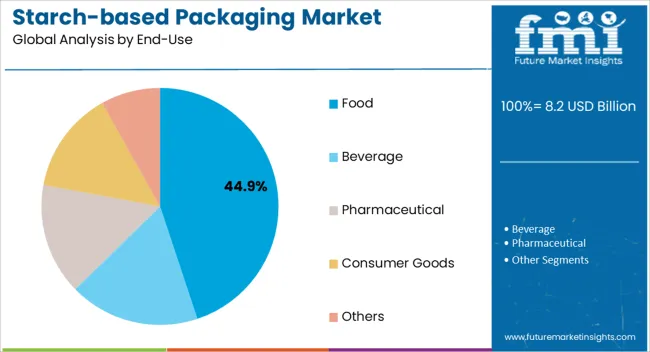
The food end use segment is anticipated to hold 44.90% of total market revenue by 2025, establishing it as the leading application area. This growth is driven by the sector’s high volume packaging needs and increasing reliance on biodegradable formats to replace plastic based alternatives.
Starch based packaging offers food safety, durability, and compostability, making it suitable for fresh produce, ready to eat meals, and takeaway packaging. The push from regulators and food brands to adopt environmentally responsible solutions has further reinforced its leadership.
As a result, food remains the most influential end use driving the starch based packaging market forward.
In recent years, there has been a surge of interest in starch-based packaging as an environment-friendly alternative to plastic packaging. This has resulted in increased research and development in the field, as well as a rise in demand for starch-based-based materials. This trend is likely to continue as several consumers and businesses become environmentally conscious and seek sustainable packaging alternatives. The market is estimated to expand at 6.4% CAGR between 2025 and 2035, in comparison to the 4.0% CAGR registered from 2020 to 2025.
Advancements in manufacturing technology in the production of starch-based products are estimated to boost market expansion even further.
New manufacturing techniques and material formulations with increased strength, durability, and barrier qualities are being developed, making them appropriate for a wide range of packaging solutions.
Another possibility is the potential for product creation and innovation. Starch-based packaging can be tailored to fit the needs of various sectors and products. Packaging for food products, for example, may require different qualities than packaging for electronics or medical devices.
Companies that continue to engage in research and development may be able to produce new starch-based packaging solutions with improved performance and functionality.
The growing demand for e-commerce has created a demand for packaging that is both environment-friendly and provides adequate protection during shipping. As starch-based packaging can be designed to provide excellent cushioning and shock absorption, it is an excellent choice for e-commerce packaging.
There is a chance for businesses to profit from government regulations and incentives. Many governments around the world are enacting policies to encourage the use of environment-friendly packaging materials, such as starch-based packaging. Companies that invest in these materials may be eligible for tax breaks or other financial assistance.
FMI Anticipates the Segment Acquired more than 53.9% of the Market Share in 2025.
Tableware has a prominent share of the starch-based packaging market since it is a typical item used in large quantities in the food service industry.
Starch-based polymers are often less expensive to manufacture than standard plastics, and they may be mass-produced. As a result, they are a cheap option for food service organizations that require big numbers of dinnerware.
Tableware made from starch is versatile and can be utilized in a variety of food service applications. It comes in a range of forms, sizes, and colors, making it simple to pick the correct sort of dinnerware for various types of food and drinks.
Food Businesses to Acquire 60.5% Market Share of the Starch-based packaging market.
Given the strong demand for packaging materials to transport and preserve food products, the food sector leads the starch-based packaging market. Starch-based packaging is an environment-friendly alternative to standard plastic packaging, which aligns with the food industry's concept of sustainability. Furthermore, starch-based packaging is biodegradable and compostable, making it appropriate for food products as well as environment-friendly.
The food business has strict standards for safety and quality, which starch-based packaging meets. Finally, as customers grow environmentally conscious, there is an increased need for eco-friendly products, such as food wrapped in sustainable materials, leading to an increase in demand for starch-based packaging.
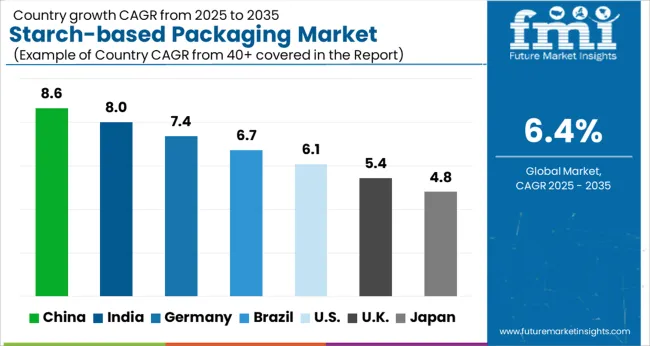
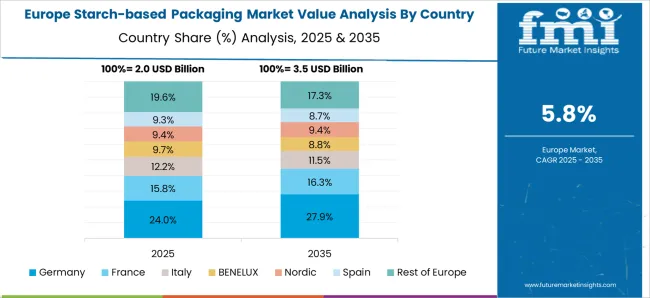
The European Union has put policies and regulations in place to encourage the use of sustainable packaging materials, such as starch-based packaging. As a result, the region's demand for starch-based packaging has increased.
Many countries in Europe have set goals to reduce plastic waste and promote the use of biodegradable materials, increasing the demand for starch-based packaging solutions. In Europe, the food and beverage industry is a key end-user of starch-based packaging. Highly fragmented take-out outlets as well as cafeterias are the primary contributors to starch-based packaging solutions.
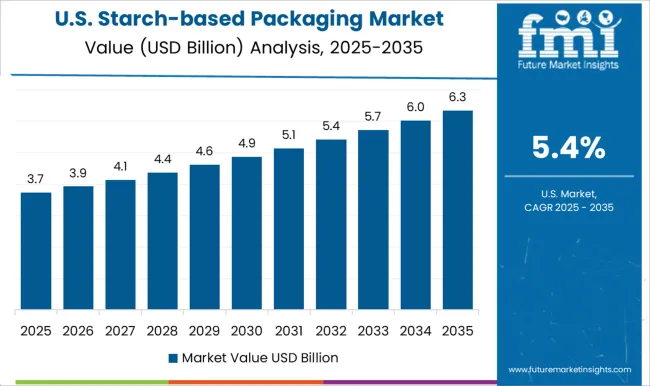
The United States government has taken initiatives to encourage the use of biodegradable and compostable packaging materials. The Break Free from Plastic Pollution Act, enacted in 2024, would oblige manufacturers to accept responsibility for their plastic trash and minimize the number of single-use plastics generated in the country. This could raise demand for alternative packaging materials like starch-based packaging.
The United States is home to several important participants in the starch-based packaging business, including Plantic Technologies, Inc., Eco-Products, and NatureWorks LLC. These companies are actively involved in the development and manufacture of starch-based packaging solutions, which contribute to the region's market growth.
Region to witness a CAGR of 9.5% during the Analysis Period.
The country's vast population and expanding economy have led to an increase in the consumption of packaged goods, which has also increased the demand for packaging materials, including starch-based packaging.
The government of China has enacted policies and regulations to encourage the use of environment-friendly and sustainable packaging materials. The country approved a new standard for biodegradable plastics, including starch-based polymers, in 2024. This has increased production and consumption by encouraging the use of starch-based packaging throughout the country.
The food industry has adopted sustainable packaging alternatives, including starch-based packaging to fulfill the increased customer demand for eco-friendly products.
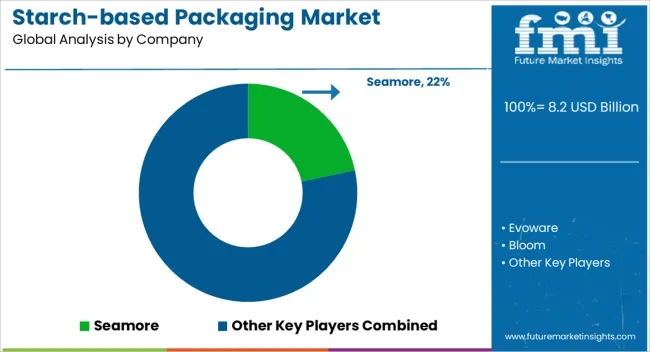
Some of the key players in the market include Cargill, Inc., Roquette Frères, Plantic Technologies, Inc., Novamont S.p.A., and NatureWorks LLC. These companies are involved in the development, manufacturing, and distribution of starch-based packaging solutions. They have a significant market presence in various regions around the world. They are also investing in research and development to improve the quality and performance of their products and to stay competitive in the market.
There are also several small companies in addition to these large players focused on developing innovative and niche starch-based packaging solutions. These companies often operate in specific regions or markets and may specialize in specific types of products or applications.
The market is also witnessing collaborations and partnerships between different companies to develop and market new products and solutions.
Latest Developments:
| Attribute | Details |
|---|---|
| Growth Rate | CAGR of 6.4 from 2025 to 2035 |
| Base Year of Estimation | 2025 |
| Historical Data | 2020 to 2025 |
| Forecast Period | 2025 to 2035 |
| Quantitative Units | Revenue in USD million and Volume in Units and F-CAGR from 2025 to 2035 |
| Report Coverage | Revenue Forecast, Volume Forecast, Company Ranking, Competitive Landscape, growth factors, Trends, and Pricing Analysis |
| Key Segments Covered | By Packaging Format, By Material, By End User Industry, By Region |
| Regions Covered | North America; Latin America; Europe; East Asia; South Asia; The Middle East & Africa; Oceania |
| Key Countries Profiled | The United States, Canada, Brazil, Mexico, Germany, Italy, France, The United Kingdom, Spain, Russia, China, Japan, India, GCC Countries, Australia |
| Key Companies Profiled | Seamore; Evoware; Bloom; CuanTec; Starch-based Energy Solutions; AlgaePac; Algopack; Sea6 Energy; Oceanium; Cascadia Starch-based |
| Customization & Pricing | Available upon Request |
The global starch-based packaging market is estimated to be valued at USD 8.2 billion in 2025.
The market size for the starch-based packaging market is projected to reach USD 15.2 billion by 2035.
The starch-based packaging market is expected to grow at a 6.4% CAGR between 2025 and 2035.
The key product types in starch-based packaging market are tableware, films and wraps, pouches and bags, bottles and cups, boxes and cartons and others.
In terms of material, thermoplastic starch (tps) segment to command 57.2% share in the starch-based packaging market in 2025.






Full Research Suite comprises of:
Market outlook & trends analysis
Interviews & case studies
Strategic recommendations
Vendor profiles & capabilities analysis
5-year forecasts
8 regions and 60+ country-level data splits
Market segment data splits
12 months of continuous data updates
DELIVERED AS:
PDF EXCEL ONLINE
Starch-Based Bioplastics Packaging Market Insights - Growth & Forecast 2025 to 2035
Packaging Barrier Film Market Size and Share Forecast Outlook 2025 to 2035
Packaging Films Market Size and Share Forecast Outlook 2025 to 2035
Packaging Laminate Market Size and Share Forecast Outlook 2025 to 2035
Packaging Burst Strength Test Market Size and Share Forecast Outlook 2025 to 2035
Packaging Tapes Market Analysis - Size, Share, & Forecast Outlook 2025 to 2035
Packaging Materials Market Size and Share Forecast Outlook 2025 to 2035
Packaging Labels Market Size and Share Forecast Outlook 2025 to 2035
Packaging Equipment Market Size and Share Forecast Outlook 2025 to 2035
Packaging Tubes Market Trends and Growth 2035
Packaging Resins Market Size and Share Forecast Outlook 2025 to 2035
Packaging Inspection Systems Market Size and Share Forecast Outlook 2025 to 2035
Packaging Design And Simulation Technology Market Size and Share Forecast Outlook 2025 to 2035
Packaging Suction Cups Market Size and Share Forecast Outlook 2025 to 2035
Packaging Straps and Buckles Market Size and Share Forecast Outlook 2025 to 2035
Packaging Coating Market Analysis - Size, Share, & Forecast Outlook 2025 to 2035
Packaging Testing Services Market Analysis - Size, Share, and Forecast 2025 to 2035
Packaging Testing Equipment Market Analysis & Growth 2025 to 2035
Packaging Bins Market Trends - Growth & Demand 2025 to 2035
Packaging Inserts Market Insights - Growth & Forecast 2025 to 2035

Thank you!
You will receive an email from our Business Development Manager. Please be sure to check your SPAM/JUNK folder too.
Chat With
MaRIA